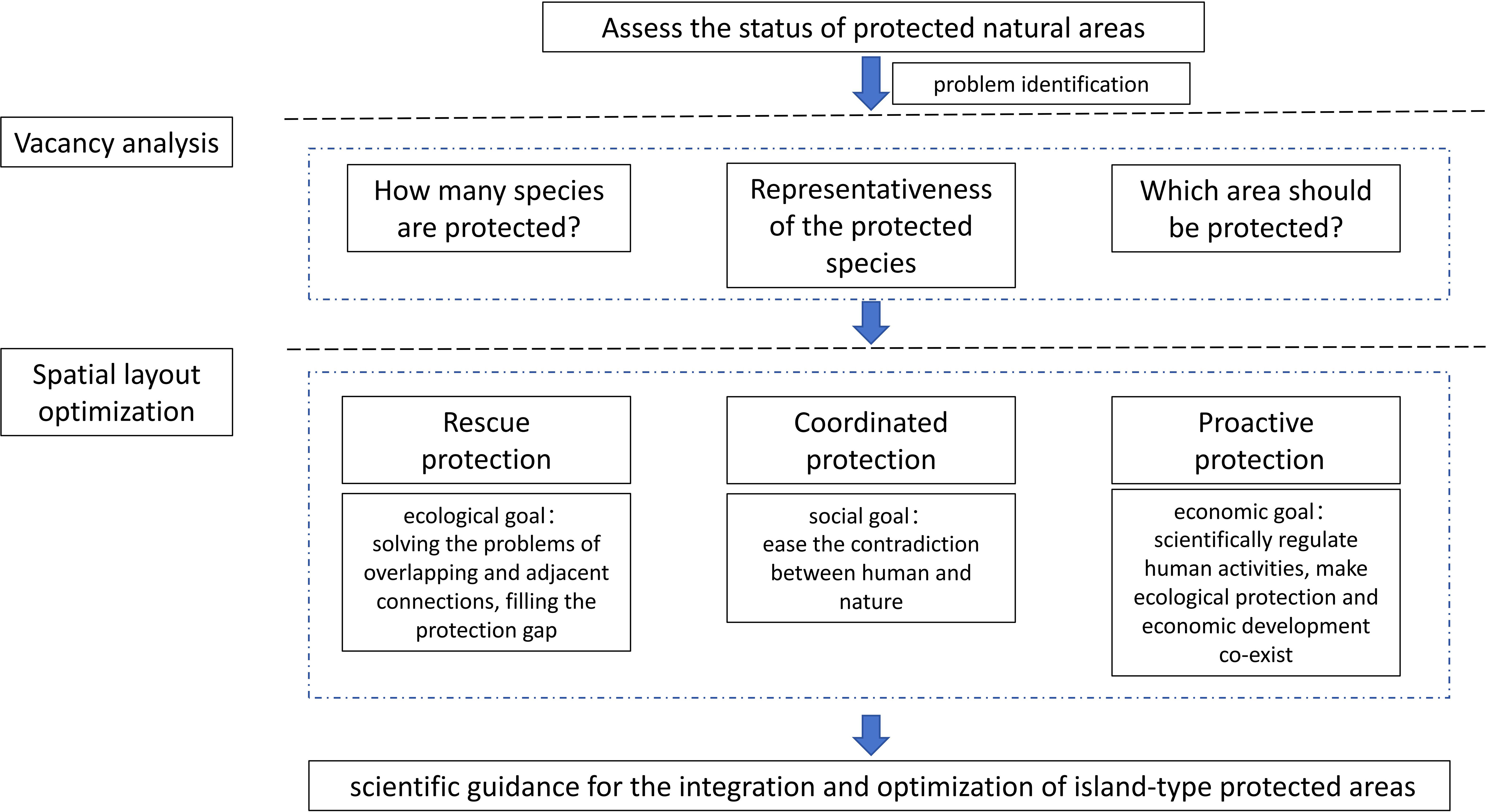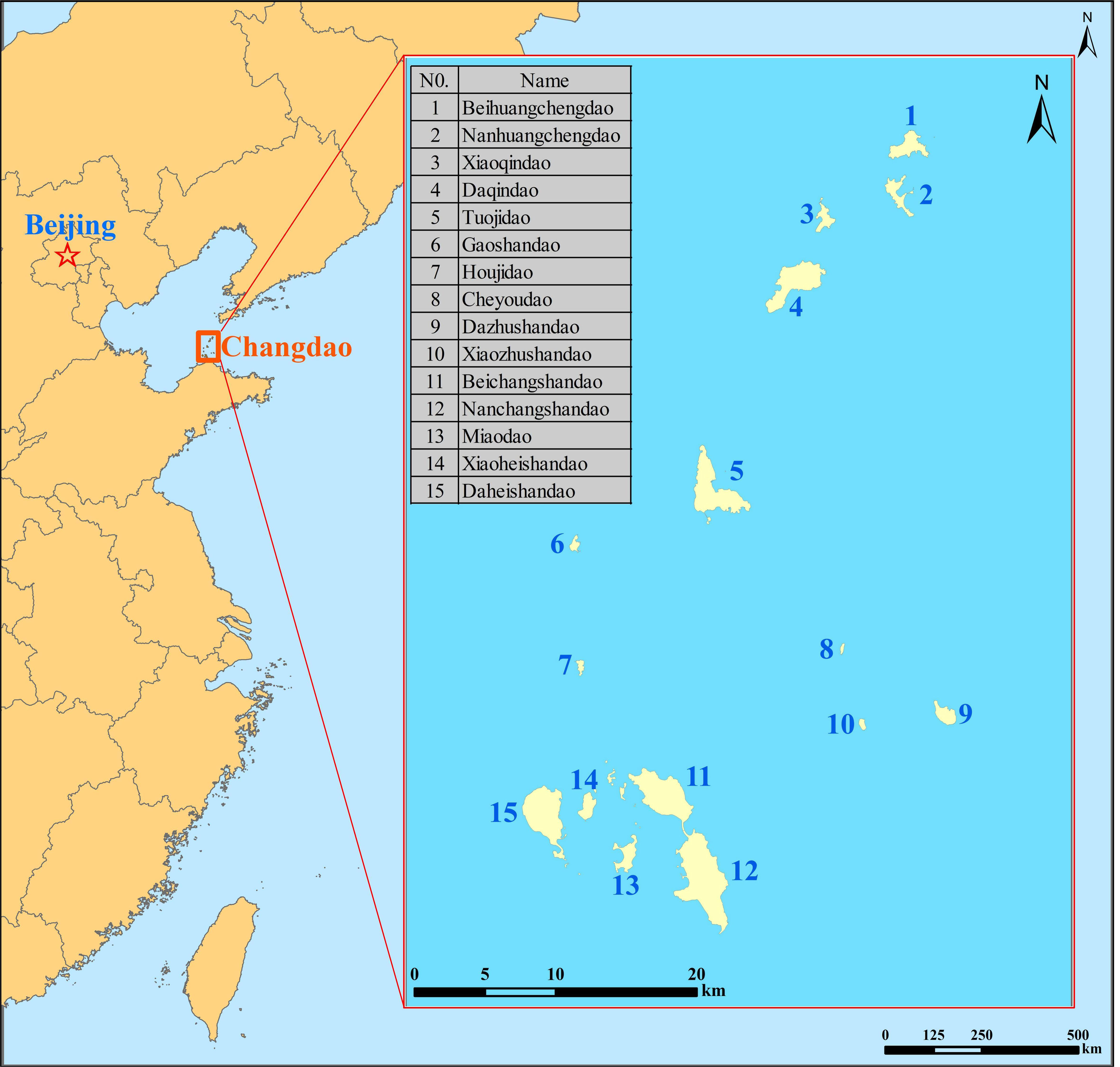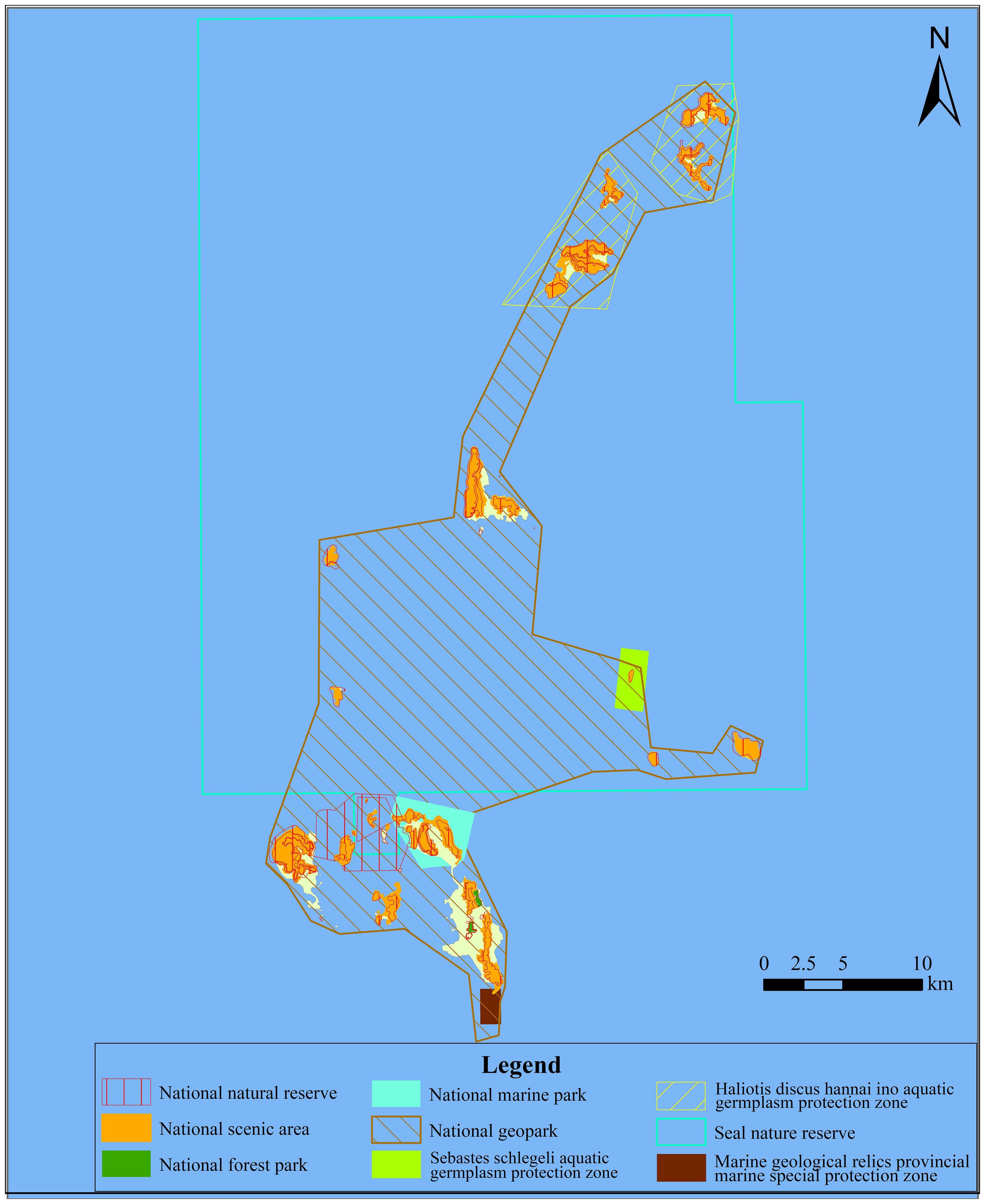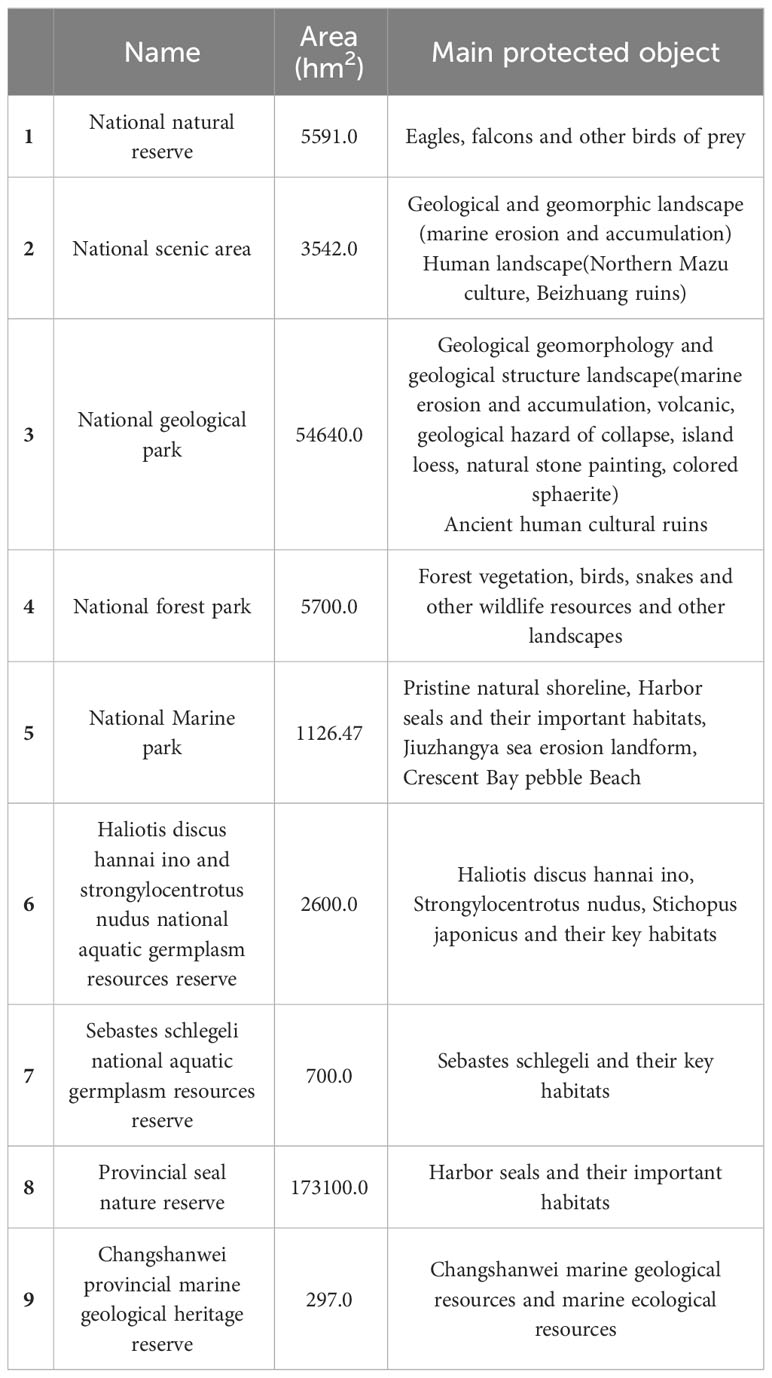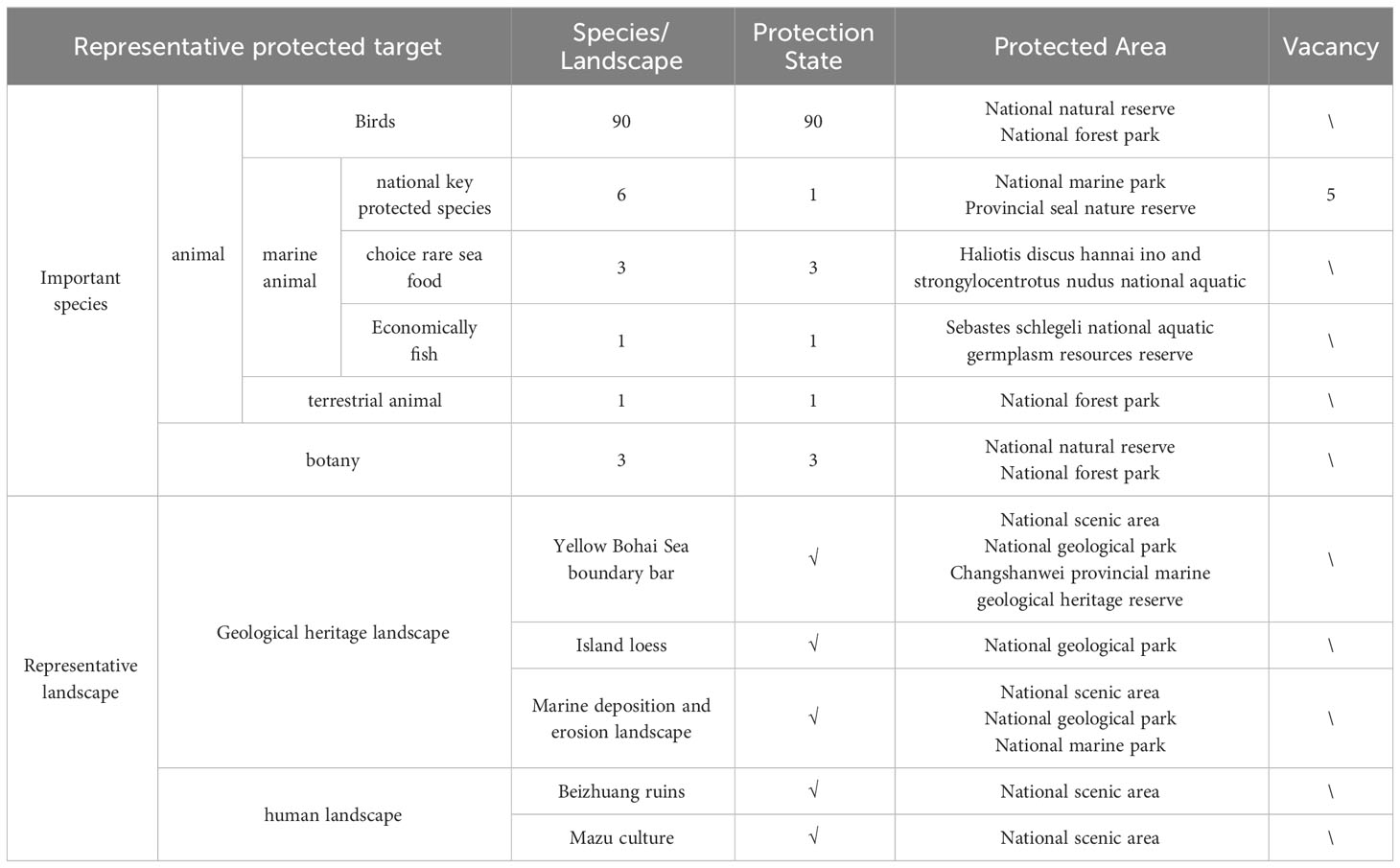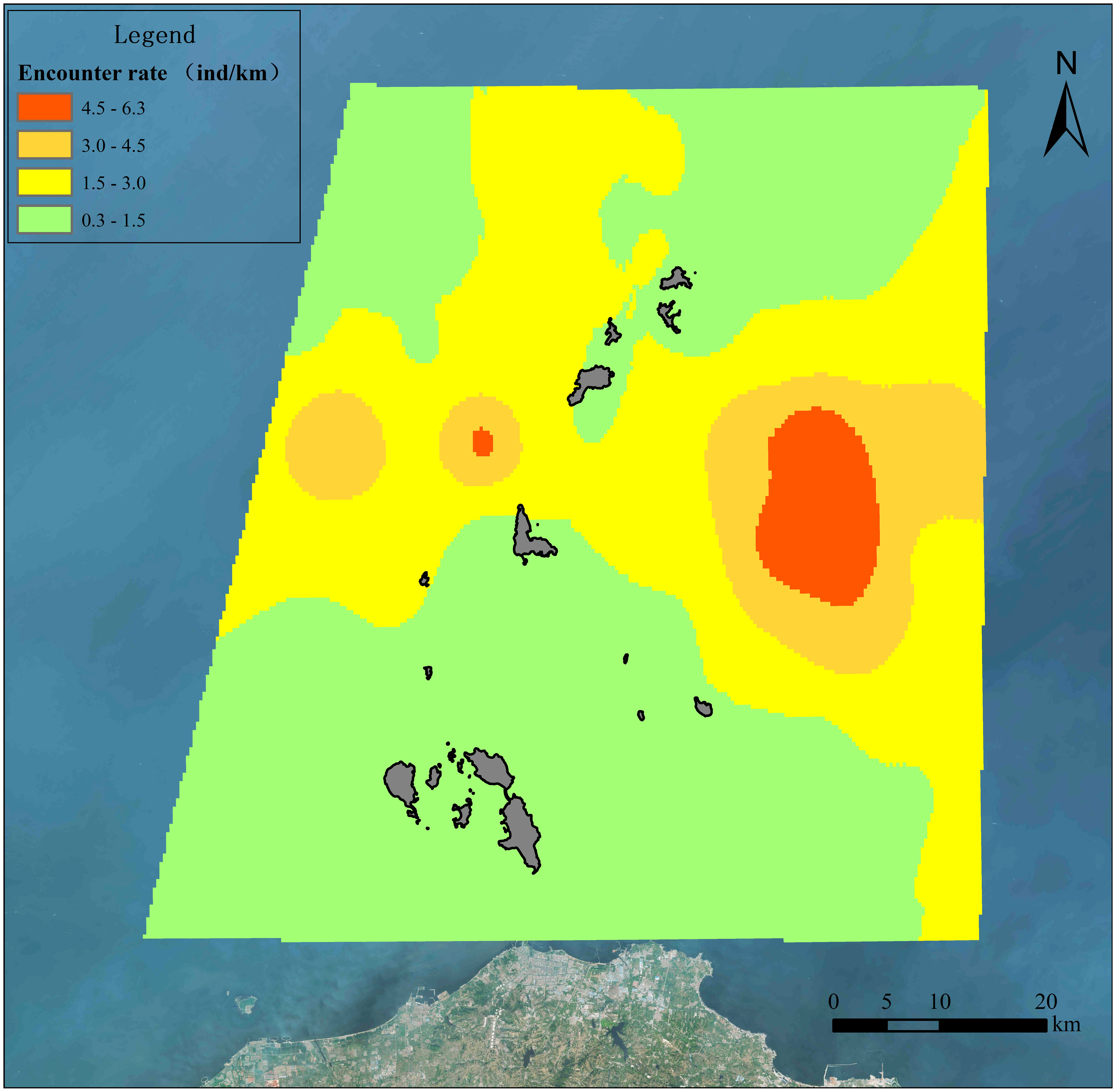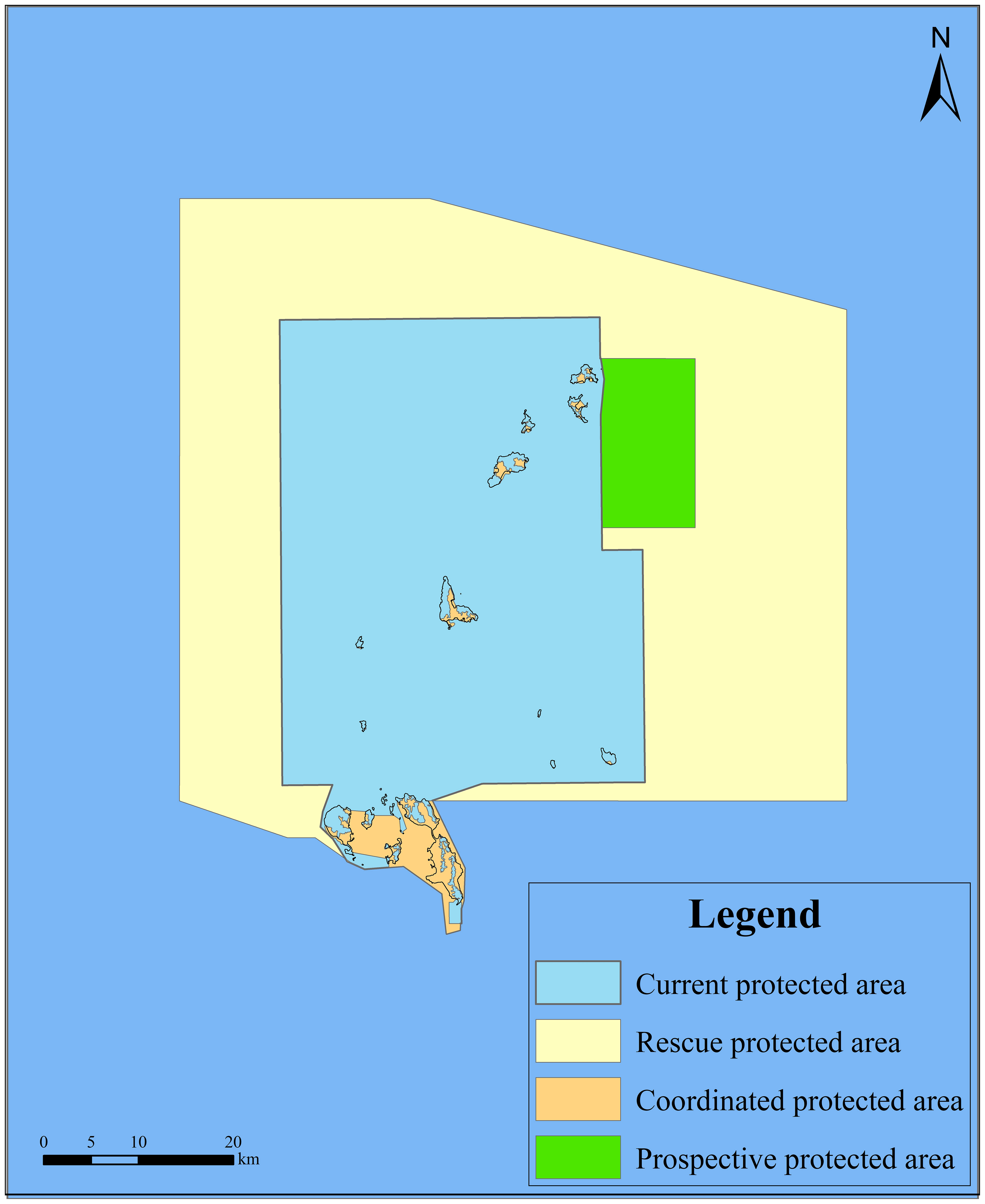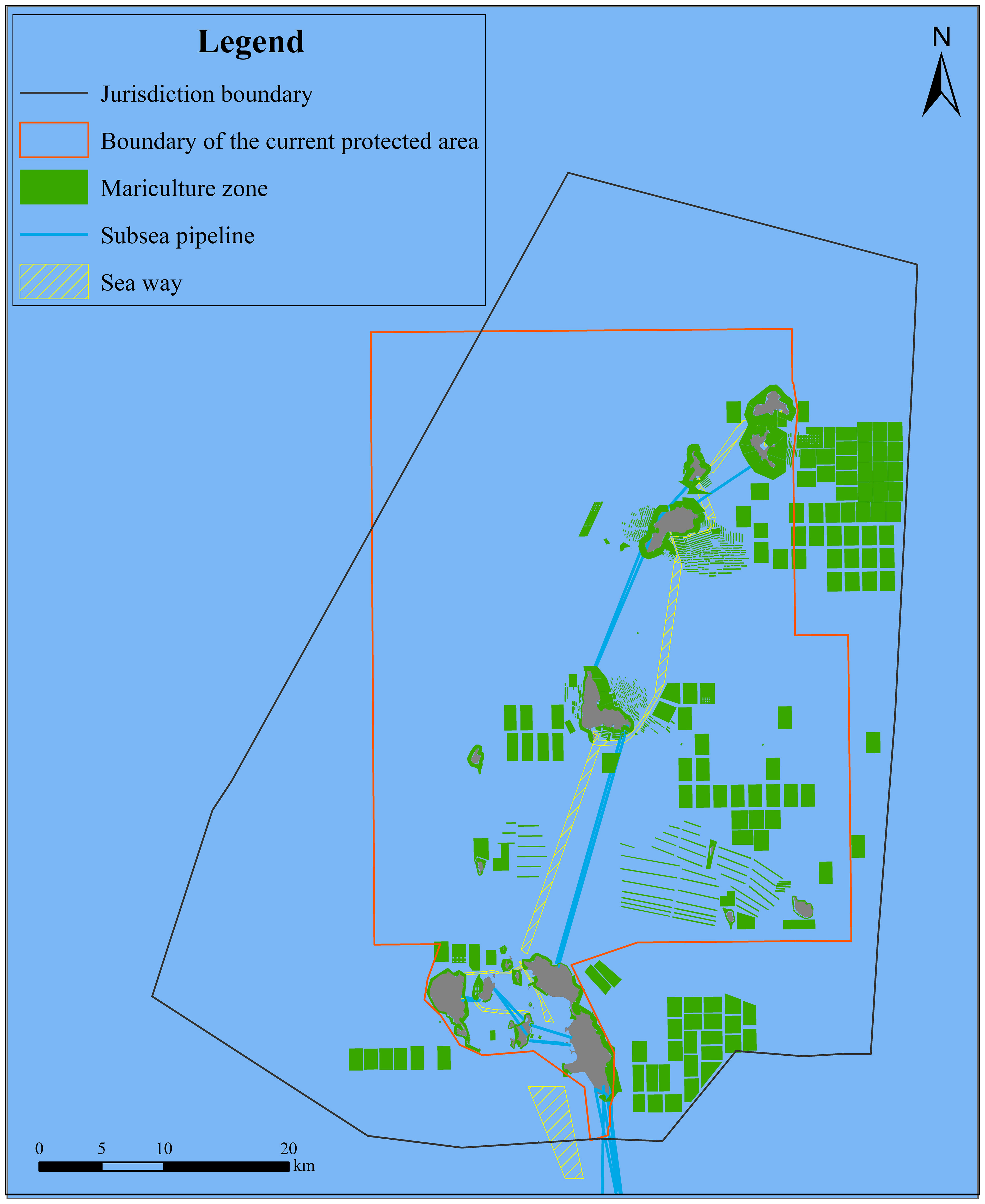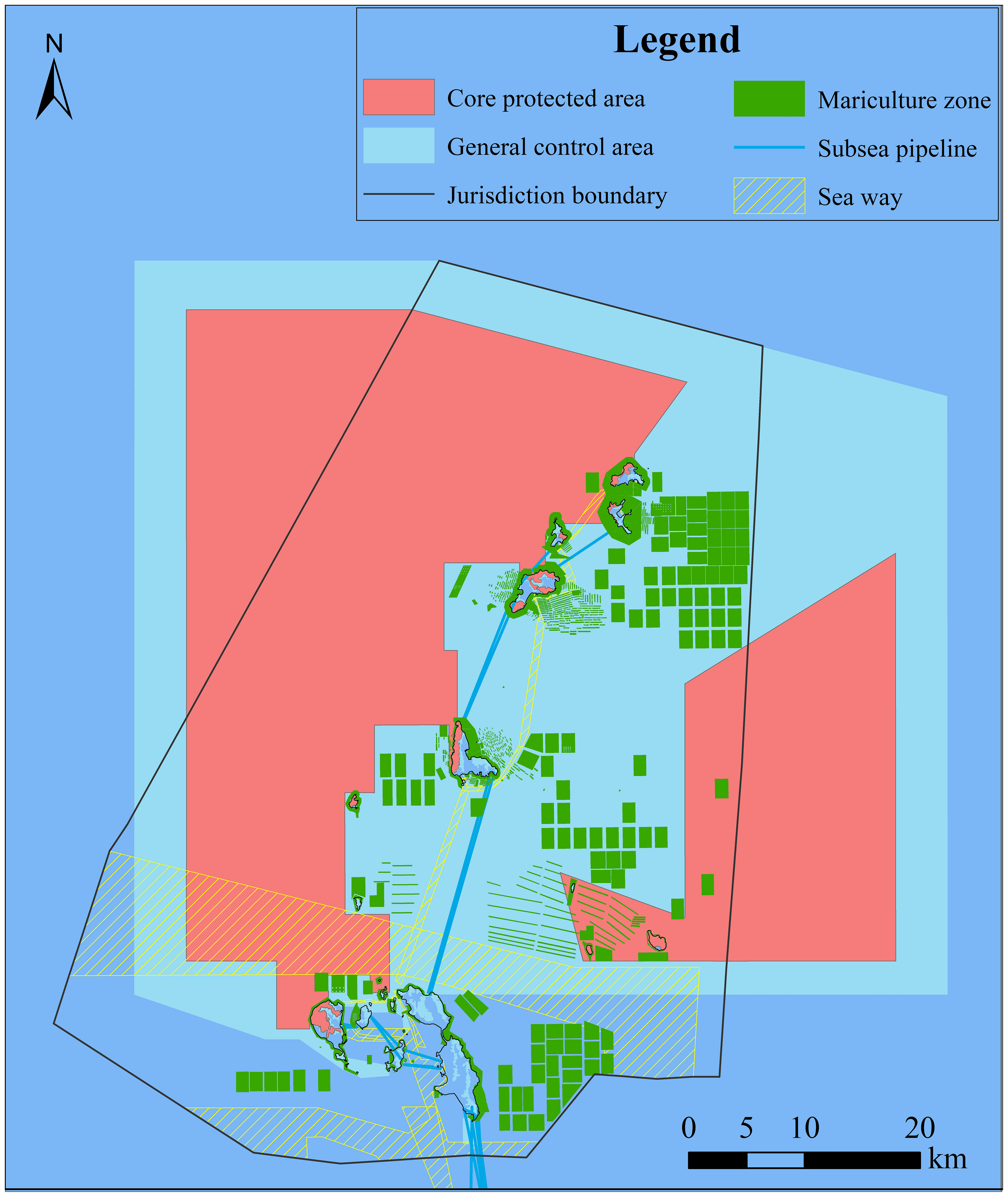- 1First Institute of Oceanography, Ministry of Natural Resources, Qingdao, China
- 2Fujian Provincial Key Laboratory of Coast and Island Management Technology Study, Fujian Institute of Oceanography, Xiamen, China
- 3Changdao National Marine Park Management Center, Marine Ecological Civilization Comprehensive Experimental Area of Changdao, Yantai, China
Research on vacancy analysis and spatial layout of protected natural areas has been carried out for many years around the world, but most of the research objects are land-type protected natural areas, while studies on Marine protected natural areas are relatively rare, and there are few cases to carry out integrated optimization research on spatial layout of protected natural areas. This study will take Changdao in Yantai, Shandong Province, China as an example, from the protection of how much? How representative? Where is it protected? Starting from the three problems, the vacancy analysis is carried out, and the integrated optimization research is carried out based on the existing spatial layout, aiming at the rescue protection, coordinated protection and forward-looking protection. The results show that the integrated and optimized Changdao protected area eliminates the protection vacancy, integrates the overlapping protected areas, optimizes the unreasonable protected space, alleviates the contradiction between protection and development, promotes the coordinated development of ecology and economy and society, and can provide a scientific reference for the integrated and optimized spatial layout of Marine protected areas.
1 Introduction
In recent years, under the combined impact of global climate change intensifying human activities, the ecological effects of unhealthy succession of natural ecosystems have negatively affected the quality of human life. It is therefore imperative to implement complete protection of natural ecosystems. Identifying a natural protected areas on a scientific basis would help prevent the disorderly expansion of human exploitation (McNeill, 1994; Montesino Pouzols et al., 2014; Tittensor et al., 2019). China has established a system of natural protected areas mainly comprising of national parks in an aim to protect biodiversity, preserve natural heritage, improve ecological environment quality, and strengthen national ecological security. At the same time, these natural protected areas collectively play a key role in the supply of high-quality ecological products and the provision of public services such as science, education and recreation to the whole society (General Offices of the CPC Central Committee and The State Council, 2019; Tang et al., 2019; Tang et al., 2020). As the core area of marine protected areas (Hamid et al., 2021), islands sustain a mixed terrestrial and marine ecosystems (Shi et al., 2009), playing a basic role in maintaining biodiversity (Correia et al., 2021), regulating the productivity and material cycle of the island ecosystem, and are of high conservation value (Tilman et al., 1997; Hooper et al., 2004; Cardinale et al., 2006; Wei et al., 2008). Previous works on spatial layout of natural protected areas, however, are problematic (e.g. some biologic species together with their habitats were not included) due to the lack of scientific evidence.
The analysis of protected areas in both terrestrial and marine ecosystems (forests (Wang et al., 2010; Huang et al., 2014; Wang et al., 2018; Zhang, 2022), wetland (Wang et al., 2010; Huang et al., 2014; Wang et al., 2018; Zhang, 2022; Hong et al., 2023), desert (Lu et al., 2019), grassland (Liu et al., 2014), etc.), has been intensively studied over the past several decades (Huang et al., 2022). The protected areas in islands, however, have been rarely studied. Moreover, most of the existing studies are policy-oriented guidance, instead of detailed optimization scheme for spatial layout. China is promoting the integration and optimization of protected natural areas across the country, and relevant studies have emerged, mainly covering: (1) classification system and selection index system of protected areas (Gao et al., 2019; Hou et al., 2019; Ma et al., 2019; Qu et al., 2019; Tang et al., 2019; Chen and Jiao, 2020; Li et al., 2020; Ouyang et al., 2020; Tang et al., 2020a; Zhao et al., 2020); (2) basic ecological theory of integrated optimization of protected areas (Tang and Luan, 2017; He and Su, 2019; Lin and Zhou, 2019; Jiang et al., 2021; Tang, 2021); (3) rules and procedures of integrated optimization (Ma et al., 2019; Qu et al., 2019; Huang et al., 2020; Li et al., 2020; Tang et al., 2020b; Gao et al., 2021; Liu et al., 2022);and (4) practice of integrated optimization (Shang and Wang, 2019; Liu et al., 2020; Liu et al., 2021; Luo et al., 2021; Weng et al., 2021; Zeng et al., 2021). Two shortcomings exis: (1) marine protected areas are less studied, in comparison with those on land. The boundaries of landscape units, such as mountains and forests, within the terrestrial ecosystem are clearly defined. In order to establish protected areas, the outer edge line of each landscape unit can be directly adopted. Comparing with those in island protected areas where most of the landscapes and protected items are under sea level.In order to facilitate the management and positioning of boundary point buoys, the outer boundary of the island protected area is predominantly linear. Some of the protected marine animals have long-distance migrating pathways, making it difficult to protect the whole area. Due to the inherent differences between marine and terrestrial ecosystems, the vacancy analysis and layout optimization methods of land-type protected areas may not be applicable to island protected areas; (2) There has been limited connection between vacancy analysis and layout optimization studies.
In this study, we conducted vacancy analysis to natural protected areas in the Changdao Island on three issues (Zhang and Sun, 2019): “how many species are protected”, “representativeness of the protected species” and “which areas should be protected”. We further optimize the existing spatial layout of protected areas by combining protection objectives at different levels, with a view to building an integrated optimization rule system applicable to protected areas on islands (Figure 1). Our results can provide new guidance for the integration and optimization of national marine protected areas.
2 Study area profile
Located between Liaodong Peninsula and Jiaodong Peninsula, the Changdao Island chain consists of 151 islands, spanning over 56.41 km from south to north and 30.81 km from east to west. The total administrative area of Changdao Island is 3,301.97 km2, including a land area of 59.25 km2 and a sea area 3,242.71 km2 (Figure 2). The Changdao Island chain is located on the East Asia-Australasia international bird migration route, providing a valuable resting place for migratory birds and migratory animals such as harbor seals and East Asian finless porpoises, This area therefore serves as a key “pump station” for the ecosystems in the Yellow Sea and Bohai Sea. The ecological importance of this area leads to the establishment of 9 different types of natural protected area (Figure 3; Table 1). However, there is a massive overlap in spatial layout among the 9 protected areas. For instance, one protected area was repeatedly claimed by the other 5 protected area (Wang et al., 2019). The sum of approved area of each protected area is 2,472.96 km2, far exceeding its actual protected area is 1,894.65 km2.
3 Analysis of vacancies in protected area
3.1 How many species are protected?
The Changdao Island chain is biological diverse. During the observation from May 2019 to October 2021, up to 3,543 biological species were found, including 1,541 species of plants and 2002 species of animals. Although there are many protected areas in this area, only the national nature reserve has been scientifically investigated. According to the historical statistics (listed in Table 2), most of the animals on land (excluding birds), birds, and marine animals discovered in Changdao have been protected by the Changdao National Nature Reserve, but less than half of the plant species have been protected, creating an apparent protection vacancy. This is possibly because the field investigation in 2016 had a small spatial coverage of the whole area. If all the existing protected areas are integrated as one in the future, it is necessary to update the protection list based on the latest scientific data and fill the protection vacancy. In addition, Changdao has abundant geological and cultural landscapes (Table 3) that have been formally protected.
3.2 Representativeness of the protected species
According to the latest “National Key Protected Wildlife List” issued in 2021, a total of 96 species of wildlife under national key protection have been found in Changdao, including 90 species of birds and 6 species of marine animals. Among these 90 species of birds, there are: (1) 21 Class I national key protected species including Aythya baeri, Mergus squamatus, Otis tarda, Grus leucogeranus, Grus japonensis, Saundersilarus saundersi, Phoebastria albatrus, Ciconia nigra, Ciconia boyciana, Platalea minor, Egretta eulophotes, Aegypius monachus, Clanga clanga, Aquila nipalensis, Aquila heliaca, Aquila chrysaetos, Haliaeetus albicilla, Falco cherrug, Emberiza aureola, Grus vipio, Grus monacha; (2) Class II national key protected 69 species, including Anser albifrons, Cygnus olor, Cygnus columbianus, Cygnus cygnus, Aix galericulata, Podiceps auratus and etc. Among the marine animals under national key protection, there are two Class I national protected species, namely Phoca largha, Western Pacific harbor seal, and Balaenoptera acutorostrata, minke whale. Class II national protected species: include East Asian finless porpoises (Neophocaena sunameri), killer whales (Orcinus orca), false killer whales (Pseudorca crassidens), and North Sea lions (Eumetopias jubatus). In addition, a considerable number of Gloydius changdaoensis, a vulnerable species on the IUCN Red List of Endangered Species, has been found in the the Changdao Island chain. There are also some native populations of sea curiotica found in this area, such as Haliotis discus hannai Ino, Strongylocentrotus nudus, Stichopus japonicus, Besides, it is also an important habitat for important economic fish such as Sebastes schlegelii. According to the latest List of Key Protected Wild Plants issued in 2021, excluding cultivated plants, there are three species of wild vascular plants under national Class II protection namely Zoysia sinica, Glycine soja and Glehnia littoralis. In addition, several geologically and historically important landscapes are located in this area, including the sandbank that separates the Yellow Sea and Bohai Sea, the rarely-found island loess, coastline progradation and retreat, ancient societal relics and Mazu culture. According to the main objectives of the existing protected areas, most birds, choice rare sea food, important economic fish, land animals, plants, geological heritage landscape and cultural landscape with important protection value have been included in the protection list, but among the marine animals under key national protection, only the Western Pacific harbor seal has been included in this list. Minke whales, East Asian finless porpoises, killer whales, false killer whales, and North Sea lions are still unprotected.
3.3 Which area should be protected?
As shown in Figure 2, long-distance migratory species such as birds and harbor seals, key protected plants, and coastal erosion landscapes are distributed in each island and its surrounding waters. The main protection areas for the native populations of sea treasures such as sea cucumber are Daqin Island, Xiaoqin Island, South Huangcheng Island and North Huangcheng Island. The protection area of the Sebastes is located in Cheyou Island. The main protection areas of Miaodao Gloydius are located in Nanchangshan Island, Beichangshan Island, Daheishan Island, Xiaoheishan Island and Miaodao Island. The boundary sandbank separating the Yellow Sea and Bohai Sea is located at the tail of Changshan Mountain in the south of Nanchangshan Island. The loess is mainly distributed in Daheishan Island and Tuoji Island. Beizhuang site is located on Daheishan Island; The main protection area of Mazu culture is located on the Miao Island.
At present, minke whales, East Asian finless porpoises, killer whales, pseudo-killer whales, and northern sea lions are still un-protected, and their living domains remain unclear. Surveys performed from 2019 to 2020 reveal that the East Asian finless porpoise appeared mainly in the waters to the east and west of the Changdao Island chain, demonstrating that there is still a total area of 575 km2 uncovered by the existing protected areas. The living domains of Minke whales, orcas, pseudo-orcas, and Beihai lions remain poorly determined. Existing evidence only comes from fisherman’s occasional witness. For example, minke whales have appeared in the northern waters of Beichangshan Island, orcas appeared in the northern waters of Beichang Island and the eastern waters of Tuoji Island, pseudo-orcas appeared in the eastern waters of Changdao Island, and Beihai lions appeared in the waters around Daqin Island and Nanhuangcheng Island.
4 Optimization of protected area’s spatial layout
In this study, the spatial layout of natural protected areas in Changdao will be optimized with the goals of “rescue protection”, “coordinated protection”, and “forward-looking protection”. The goal of “rescue protection” is an ecological goal, which aims to integrate the overlapping of space and fill the protection gap. The goal of “coordinated protection” is a social goal, which aims to ease the contradiction between the protected areas and their surrounding residential communities, and promote the coexistence of ecology and society. “Forward-looking protection” is an economic goal, that aims to explore the economic benefit provided by these natural protected areas.
4.1 “Rescue protection” optimization
The “rescue protection” optimization aims to solve the problems of overlapping and adjacent connections, and to fill the protection gap. Following the guidance of relevant documents (Ministry of Natural Resources and National Forestry and Grassland Administration, 2020; He et al., 2021), the national nature reserve is treated as the main body, with the other 8 protected areas included, transforming the core protected areas and buffer areas of national nature reserve and provincial seal nature reserve into core protected areas, and the remaining areas are transformed into general control areas. The “protection gap” area included in the protected area mainly considers the spatial coverage of waters where the East Asian finless porpoise appear most, which is located in the east and west sea areas in the middle of the Changdao Island chain (Figure 4) (Wang et al., 2019). This area is little disturbed by human activities, owing to the non-existing aquaculture or submarine pipelines, minor fishing activity that is concentrated mostly in September-April, and less shipping. This area, if protected, will largely improve the habitat for the East Asian finless porpoise (Figure 5).
4.2 “Coordinated protection” optimization
The optimization of “coordinated protection” aims to ease the contradiction between human and nature by adjusting the spatial layout of protected land. The Regulations of the People’s Republic of China on Nature Reserves expressly stipulate that “only scientific research and observation activities are allowed in the buffer zone of nature reserves” and “tourism, production and business activities are prohibited in the buffer zone of nature reserves”. However, the buffer zone of Changdao National Nature Reserve is filled with many human activities such as aquaculture and shipping (Figure 4). Due to the lack of overall consideration, the national geology park, the Miaodao Islands Provincial Seal Nature Reserve and other protected areas were incorporated into the protected areas at the beginning of their establishment. In particular, the Miaodao Bay area, which is surrounded by the five islands in the south, is intensively disturbed by human activities including raft, bottom seeding, cage farming, shipping, submarine pipeline maintenance, port channel dredging, urbanization, and etc. These sea waters have low protection value due to the substantial alteration from their original state, and will be a wasted of money if listed as a protected area. Moreover, the sea area is not the habitat for harbor seals, East Asian finless porpoises, and other economic sea production. Excluding it from the protected areas will not affect the inherent ecological connectivity of the sea area. It not cut off the migration route, and destroy the habitats for the key protected species. At the same time, excluding those human-dominated lands from the protected areas, (e.g., agriculture and fishery land, residential land, public facility service land, commercial service land), will not impact the protected targets but will help alleviate the contradiction between protected land and surrounding communities.
After the boundary of the protected area is determined, the internal partition is optimized. The core protected area is a key area to maintain the normal reproduction, and migration of rare animal populations. It is also an important area to realize the complete protection of the island land-intertidal and shallow sea ecosystem, and also an area to adopt the strictest control measures. In order to achieve effective protection of the main conservation objectives, the core areas and buffer areas of existing nature reserves shall be transformed. And original genuine, higher sensitivity to human activities, the forest park of ecological conservation area, the leopard seal, east Asia finless porpoises and active region of rare and endangered Marine life and migration routes, trepang and wrinkles dish bao, light spines ball sea urchins and other marine products native populations the main distribution area of priority to delimit core protection area. All areas outside the core protected areas are included in the general control areas. This area also has high ecosystem authenticity and greater protection value, but it is difficult to implement the strictest control because of the high human disturbance, so it is included in the general control area control.
4.3 “Proactive protection” optimization
The “forward-looking protection” optimization aims to scientifically regulate human activities by adjusting the spatial layout of protected areas and using the management and control measures of protected areas, so that ecological protection and economic development can co-exist. Aquaculture and tourism are the two biggest contributors to the economy of Changdao. If all the aquaculture and tourism areas are excluded from the protected areas, the lack of control measures of the protected areas may lead to a protection crisis due to disorderly breeding and the surge in the number of tourists, and reduce the effectiveness of protection (in the history of Changdao, a large number of scallops died and a decrease in production in successive years due to the disorderly expansion of aquaculture). Therefore, the concentrated distribution sea area (Figures 5, 6) located in the eastern part of the four islands in the north is included in the general control area of the protected area. The sea area is relatively open, with high flow velocity, and the aquaculture areas are in an open farming mode. This openness will not block the of migratory route for species such as harbor seals and East Asian finless porpoises. Moreover, this will not threaten the ecological environment. At the same time, the control measures of protected areas are used to scientifically control the scale and intensity of aquaculture and tourism based on the ecological environmental carrying capacity, to improve the aquaculture production and tourism services. At the same time, it can also rely on the brand effect and publicity advantages of the integrated national nature reserves or even national parks to provide more high-quality ecological products for the society.
After the above integration and optimization, nine nature protected areas in Changdao were merged into Changdao National Nature Reserve (Figure 7; Table 4), with a total area of 4,269.68 km2, This area is 2375.03 km2 larger than the previous one, with the core protected areas and general control areas respectively increased by 1723.1 km2 and 651.93 km2. The percentage of core protected areas increased from 17% to 48%, which will be favorable to sustain the authenticity and integrity of the ecosystem. After superposing the development and utilization status of the integrated and optimized protected area spatial layout, the cross-overlap in protected area space and the derived multiple management problems have been eliminated through the integrated optimization, the protection vacancy space of the important habitat of the East Asian finless porpoise has been filled, and the residential area with high human interference and low protection value has been transferred. It will be transferred into the concentrated distribution of marine pastures that will be an important production area of high-quality ecological products to promote development through protection, which can promote the coordinated development of ecology, society and economy in Changdao.

Table 4 The area changes of Changdao protected areas before and after integration and optimization (km2).
5 Outlook
The purpose of this study is to explore an integrated optimization method applicable to natural protected areas on islands. This method can jointly protect the key protection objectives, promote the coordinated improvement of the social and economic development of the surrounding communities, and enable the local residents to benefit from ecological protection. Our method used in this study can provide scientific guidance for the integration and optimization of island-type protected areas in China and even in the world. In the future, there is still a high necessity to strengthen the following research directions: (1) At present, China’s system of natural protected areas are mainly divided into three types: national parks, nature reserves, and nature parks. Among them, national parks and nature reserves are further divided into core protected areas and general control areas, while the entire area of nature parks is general control area. In order to achieve fine management of natural protected areas, differentiated management strategies, such as time-sharing and zoning, can be explored based on the life history of the main protected objects and their sensitivity to human activities; (2) the habitats of marine organisms are not generally limited to a single natural protected area, especially for those long-distance migratory species. In order to protect the targeted species throughout their lives, further research on ecological corridors and network connectivity of protected areas should be strengthened; (3) In order to enhance the integrated optimization of protected areas on a scientific basis and explore more detailed methods, it is necessary to improve the evaluation framework of ecosystem integrity and authenticity of protected areas; (4) In order to fully demonstrate and continuously track all aspects of the impact brought by the integration and optimization of protected areas, it is necessary to carry out studies on socio-economic impact assessment and performance evaluation of protected areas.
Data availability statement
The original contributions presented in the study are included in the article/supplementary material. Further inquiries can be directed to the corresponding author.
Author contributions
SH: Conceptualization, Data curation, Formal Analysis, Investigation, Methodology, Project administration, Resources, Software, Validation, Visualization, Writing – original draft. TX: Data curation. ML: Methodology, Resources, Validation, Writing – review & editing. WL: Conceptualization. JZ: Data curation. YL: Investigation, Data curation. SC: Project administration, Investigation.
Funding
The author(s) declare financial support was received for the research, authorship, and/or publication of this article. This study is funded through National Key Research and Development Program of China (2023YFE0113100).
Conflict of interest
The authors declare that the research was conducted in the absence of any commercial or financial relationships that could be construed as a potential conflict of interest.
Publisher’s note
All claims expressed in this article are solely those of the authors and do not necessarily represent those of their affiliated organizations, or those of the publisher, the editors and the reviewers. Any product that may be evaluated in this article, or claim that may be made by its manufacturer, is not guaranteed or endorsed by the publisher.
References
Cardinale B. J., Srivastava D. S., Duffy J. E., Wright J. P., Downing A. L., Sankaran M., et al. (2006). Effects of biodiversity on the functioning of trophic groups and ecosystems. Nature 443 (7114), 989–992. doi: 10.1038/nature05202
Chen Y. H., Jiao M. F. (2020). Literature review and inspiration of the classification of Chinese natural reserves. Planners 36 (15), 5–12.
Correia E., Granadeiro J. P., Regalla A., Catry P. (2021). Coastal waters of a marine protected area of the Bijagós Archipelago, West Africa, shelter juvenile fishes of economic and ecological importance. Regional Stud. Mar. Sci. 46 (IO), 101892. doi: 10.1016/j.rsma.2021.101892
Gao J. X., Liu X. M., Zhou D. Q., Ma K. P., Wu Q., Li G. Y. (2021). Some opinions on the integration and optimization of natural protected areas in China. Biodiversity Sci. 29 (03), 290–294. doi: 10.17520/biods.2021051
Gao J. X., Xu M. J., Zou C. X. (2019). Development achievement of natural conservation in 70 years of new China. Environ. conformity Assess. 11 (04), 25–29. doi: 10.16868/j.cnki.1674-6252.2019.04.025
General Offices of the CPC Central Committee, The State Council. (2019). Guidelines on establishing a system of protected natural areas with National parks as the main body. China: CPC Central Committee.
Hamid S. K., Teniwut W. A., Renhoran M., Teniwut R. M. K. (2021). A novel framework for marine protected areas in small island regions using integrated local wisdom. Regional Stud. Mar. Sci. 45 (11), 101819. doi: 10.1016/j.rsma.2021.101819
He S., Hao L., Li Y. X., Chen S. (2021). Study on the integration and optimization of natural protected areas in Islands from the perspective of reform: A case study of Changdao Island. Bull. Oceanology Limnology 43 (6), 154–160. doi: 10.13984/j.cnki.cn37-1141.2021.06.021
He S. Y., Su Y. (2019). Authenticity, integrity, connectivity and coordination-conceptual analysis and practical significance for the establishment of the national park system. Environ. Prot. 47 (3), 28–34. doi: CNKI:SUN:HJBU.0.2019-Z1-009
Hong Q. L. I. Y. Y., Hu J., Shi Y. Z., Cui X. L., Zhang H. X., Peng F. J. (2023). Spatial distribution characteristics and vacancy analysis of nature reserves in Hunan Province. J. Hubei Univ. (Nat. Sci.) 45 (01), 63–72. doi: 10.3969/j.issn.1000-2375.2022.00.016
Hooper D. U., Chapin F. S., Ewel J. J., Hector A., Setala H. (2004). Effects of biodiversity on ecosystem functioning:a consensus of current knowledge. Ecol. Monogr. 75 (1), 3–35. doi: 10.1890/04-0922
Hou P., Liu Y. P., Rao S., Tian J. L., Zhu Y. P., Xiao R. L., et al. (2019). National Park:inheritance and innovation of China's nature reserves. Environ. Ecol. 1 (07), 1–7. doi: CNKI:SUN:HJSX.0.2019-07-003
Huang B. R., Zhang C. L., Deng R. (2020). The systemic solution to historical problems in China's natural protected areas. Biodiversity Sci. 28 (10), 1255–1265. doi: 10.17520/biods.2020318
Huang P., Xu W. H., Fan X. Y., Han M. (2022). Evaluation and vacancy analysis of priority areas for the protection of rare and endangered mammals on the Tibetan Plateau. Environ. Prot. Sci. 48 (03), 1–6. doi: 10.16803/j.cnki.issn.1004-6216.2022.03.001
Huang Z. Q., Lu L., Dai N. H., Jiao G. Y. (2014). Analysis of vacancy in development layout of nature reserves in Jiangxi Province. Acta Ecologica Sin. 34 (11), 3099–3106. doi: 10.5846/stxb201307181911
Jiang N., Xu W. H., Zhao J. J., Xiao Y. (2021). Concept and assessment method of ecosystem authenticity:The case of Changbai Mountains area. Biodiversity Sci. 29 (10), 1288–1294. doi: 10.17520/biods.2020490
Li J. L., Chen Y. H., Wu C. Z., Zhang T. S., Liu Y., Shi L. X., et al. (2020). Natural reserve system: Chinese approach. City Plann. Rev. 44 (02), 50–58. doi: 10.11819/cpr20200209s
Lin K. X., Zhou M. (2019). Difficulty and reconstruction of establishing natural reserve system with national parks as the main body. Planners 35 (17), 5–10. doi: 10.3969/j.issn.1006-0022.2019.17.001
Liu X. Q., Wang Y. P., Pei Y. (2014). Analysis of vacancy in nature reserve construction in Shaanxi Province. J. Northwest Univ. (Natural Sci. Edition) 44 (05), 777–780. doi: 10.16152/j.cnki.xdxbzr.2014.05.056
Liu D. P., Ouyang Z. Y., Zhang Y. J., Zou H. F., Zhong L. S., Xu J. L., et al. (2021). Development of natural protected areas in China:Opportunities and challenges. Natural Protected Areas 1 (1), 12. doi: 10.12335/2096-8981.2021020501
Liu S. Y., Liu N., Hou J. Y., Wang L. (2022). Research on the coordinated development of protected areas and regions based on biocultural diversity evaluation-Qunjia tibetan township,Xining as an example. Chin. Landscape Architecture 38 (1), 94–99. doi: 10.19775/j.cla.2022.01.0094
Liu Z. L., Sun Q. Y., Cao H., Tu X. Y. (2020). Exploration of national park boundary based on integration and optimization of protected areas: A case study of proposed Qinghai lake national park. Landscape Architecture 27 (03), 29–34. doi: 10.14085/j.fjyl.2020.03.0029.06
Li X. S., Deng W. G., Li Z., Kang X. X. (2020). Integration and optimization of protected area-thinking, response and discussion. Chin. Landscape Architecture 36 (11), 25–28. doi: 10.19775/j.cla.2020.11.0025
Lu Y. P., Xu W. H., Zhang Z. M., Zhang L., Xie S. L., Zhang J. J., et al. (2019). Analysis of conservation gaps in mangrove ecosystems in China. Acta Ecologica Sin. 39 (02), 684–691. doi: 10.5846/stxb201804080794
Luo H., Chen L., Jiang Y. L., Li C. R., Zhou F. J., Wu J. P. (2021). Landscape pattern changes and analysis for the integration and optimization of natural protected areas:A case study on Sinan County of Guizhou Province. Acta Ecologica Sin. 41 (20), 8076–8086. doi: 10.5846/stxb202011102892
Ma T. H., Lv C., Lei G. C. (2019). The spatial overlapping analysis for China's natural protected area and countermeasures for the optimization and integration of protected area system. Biodiversity Sci. 27 (07), 758–771. doi: 10.17520/biods.2019087
Ma Y. H., Huang B. R., Lin H., Zhao X. Y., Wu C. G. (2019). Thoughts on the construction of nature protected area management system in China. Ecol. Economy 35 (09), 182–186. doi: CNKI:SUN:STJJ.0.2019-09-032
McNeill S. E. (1994). The selection and design of marine protected areas: Australia as a case study. Biodiversity Conserv. 3, 586–605. doi: 10.1007/BF00114203
Ministry of Natural Resources, National Forestry and Grassland Administration. (2020). Letter on the preliminary work of the optimization and adjustment of the scope and functional zoning of nature reserves. (China: National Forestry and Grassland Administration).
Montesino Pouzols F., Toivonen T., Di Minin E., Kukkala A. S., Kullberg P., Kuusterä J., et al. (2014). Global protected area expansion is compromised by projected land-use and parochialism. Nature 516, 383–386. doi: 10.1038/nature14032
Ouyang Z. Y., Du A., Xu W. H. (2020). Research on China's protected area system classification. Acta Ecologica Sin. 40 (20), 7207–7215. doi: 10.5846/stxb20200505110
Qu F. Y., Li S. Y., Zhao L. L., Yang S. Y., Wan M. Y., Cai L. T., et al. (2019). Conservation gaps in the Yellow Sea ecological region. Biodiversity Sci. 29 (03), 385–393. doi: 10.17520/biods.2020443
Shang X. H., Wang X. J. (2019). Discussion on the integration and optimization of nature reserves and countermeasures for sustainable development. For. Resour. Mangement 06), 32–37. doi: 10.13466/j.cnki.lyzygl.2019.06.007
Shi H. H., Zheng W., Ding D. W., Lv J. B. (2009). Typical island ecosystem services and their value assessment. Mar. Environ. Sci. 28, 6, 743–748. doi: 10.3969/j.issn.1007-6336.2009.06.035
Tang X. P. (2021). National park system leads the mainstreaming of biodiversity. For. Resour. Mangement 4), 1–8. doi: 10.13466/j.cnki.lyzygl.2021.04.001
Tang X. P., Jiang Y. F., Liu Z. L., Chen J. Z., Liang B. K., Lin C. (2019). The top-level design of nature protected area system in China. For. Resour. Manage. 03), 1–7. doi: 10.13466/j.cnki.lyzygl.2019.03.001
Tang F. L., Lv X. L., Cai F., Sun H. Y., Luo W. X. (2020). Reflections on integrated optimization schemes of protected areas. Landscape Architecture 27 (03), 8–13. doi: CNKI:SUN:FJYL.0.2020-03-003
Tang F. L., Wang M. J., Sun H. Y. (2019). Reform path on management system of natural protected area. Forestry Construction 02, 1–5. doi: CNKI:SUN:LYJS.0.2019-02-002
Tang X. P., Jiang Y. F., Zhao Z. C., Liang B. K., Ma W. (2020a). Study on standards for establishing national parks in China. For. Resour. Mangement 02), 1–8+24. doi: CNKI:SUN:LYZY.0.2020-02-001
Tang X. P., Liu Z. L., Ma W. (2020b). A study on integration and optimization rules and paths for natural protected areas in China. For. Resour. Mangement 01), 1–10. doi: CNKI:SUN:LYZY.0.2020-01-001
Tang X. P., Luan X. F. (2017). Developing a nature protected area system composed mainly of national parks. For. Resour. Mangement 06), 1–8. doi: 10.13466/j.cnki.lyzygl.2017.06.001
Tilman D., Knops J., Wedin D., Reich P., Ritchie M., Siemann E. (1997). The influence of functional diversity and composition on ecosystem processes. Science 277 (5330), 1300–1302. doi: 10.1126/science.277.5330.1300
Tittensor D. P., Beger M., Boerder K., Boyce D. G., Cavanagh R. D., Cosandey-Godin A., et al. (2019). Integrating climate adaptation and biodiversity conservation in the global ocean. Sci. Adv. 5, eaay9969. doi: 10.1126/sciadv.aay9969
Wang Q. Q., Ge J. W., Li W., Zhang Z. X., Shen F., Xu X. L. (2010). Current situation and vacancy of nature reserves in Hubei Province. Environ. Sci. Technol. 33 (04), 190–195. doi: CNKI:SUN:FJKS.0.2010-04-047
Wang Y., Yu C. Y., Yang D., Yang G. W., Zheng J. X., Cai W. J. (2018). Analysis of conservation vacancies in nature reserves of Yunnan Province. Forestry survey Plann. 43 (04), 55–58+62. doi: 10.3969/j.issn.1671-3168.2018.04.012
Wang W., Zhou Y., Tian Y., Li J. S. (2019). Research progress of biodiversity conservation in protected areas. Chin. J. Biol. Diversity 30 (10), 48–61. doi: 10.17520/biods.2022459
Wei N., Wang Z. S., Leng X., Zheng J. W., An S. Q. (2008). Research progress of Marine island biodiversity conservation. Chin. J. Ecol. 27 (3), 460–468. doi: CNKI:SUN:STXZ.0.2008-03-026
Weng A. F., Fan S. Z., Lu Y. Q., Chi M. W., Liao L. Y. (2021). Comparative study on optimal integration schemes of protected areas at county level based on cost-benefit assessment:A case study of Taining county,Fujian province. J. Natural Resour. 36 (08), 2020–2037. doi: 10.31497/zrzyxb.20210809
Zeng J. N., Zeng X., Ye G. Q., Deng B. P. (2021). The development process and future trend of marine protected areas in Yangtze river delta based on the integration strategy. J. Natural Resour. 1 (1), 60–71. doi: 10.12335/2096-8981.2021011001
Zhang Y. (2022). Analysis and evaluation of the vacancy of natural protected areas in Xi 'an. hina Compr. Utilization Resour. 40 (11), 146–148. doi: 10.3969/j.issn.1008-9500.2022.11.040
Zhang T. S., Sun Y. Z. (2019). Influences of the optimization and integration of nature conservation areas on scenic spots. Natural Resource Economics China 32 (10), 8–19. doi: 10.19676/j.cnki.1672-6995.000344
Keywords: marine, natural protected area, integration, optimization, spatial arrangement
Citation: He S, Xia T, Luo M, Li W, Zhang J, Li Y and Chen S (2023) Vacancy analysis and layout optimization of Changdao natural protected area from the perspective of multi-objective collaboration. Front. Ecol. Evol. 11:1265428. doi: 10.3389/fevo.2023.1265428
Received: 22 July 2023; Accepted: 13 October 2023;
Published: 27 October 2023.
Edited by:
Wei Wang, Chinese Research Academy of Environmental Sciences, ChinaReviewed by:
Lun Lu, South China Institute of Environmental Sciences, ChinaQuan Zhou, South China Institute of Environmental Sciences, China
Copyright © 2023 He, Xia, Luo, Li, Zhang, Li and Chen. This is an open-access article distributed under the terms of the Creative Commons Attribution License (CC BY). The use, distribution or reproduction in other forums is permitted, provided the original author(s) and the copyright owner(s) are credited and that the original publication in this journal is cited, in accordance with accepted academic practice. No use, distribution or reproduction is permitted which does not comply with these terms.
*Correspondence: Shang Chen, c2NoZW5AZmlvLm9yZy5jbg==
 Shuai He
Shuai He Tao Xia1
Tao Xia1